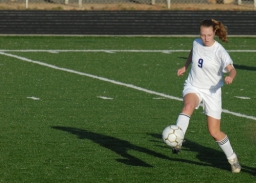The Greater Incidence of ACL Injuries in Females: Risk Factors and Prevention
Wednesday, October 4, 2017 - 10:27

The anterior cruciate ligament (ACL) is one of the ligaments inside the knee joint. Connecting the femur (thigh bone) to the tibia (shinbone), it limits the forward translation of the tibia to prevent it from sliding too far forward, and contributes to the rotational stability of the knee.
ACL sprains and tears are one of the most common knee injuries. Notably, females are 2-10 times more likely to injure their ACL than males. While there are non-contact and contact mechanisms of injury, 60-80% of ACL injuries are non-contact. They often arise from sudden deceleration, a bad landing, and/or cutting movements, usually with the knee at or near full extension. The relatively long rehabilitation process can cut short an entire athletic season, and can have lasting effects on knee health. The increasing number of females in sport and the subsequent jump in ACL injury incidence, combined with the severity of the injury, has prompted researchers to try and understand why females are at a greater risk and whether there are preventative measures.
How Females Differ from Males
Anatomy
- Increased Q angle (which involves the angle of the imaginary line from the hip to the knee) because of a wider pelvis
- Larger Q-angles have been associated with knee valgus (when the knees angle inwards) and with other knee issues
- Static measurement of Q-angle is not, however, predictive of dynamic knee valgus or risk of ACL injury
- Smaller femoral notch and smaller ACL
- Some suggest that a smaller ACL is weaker
- There is no direct correlation between ACL size and injury rate
Hormones
- Estrogen
- Contradictory findings exist about the effect of estrogen and relaxin fluctuation on ACL weakness and neuromuscular control
Neuromuscular Control: Likely the most influential aspect affecting injury risk, and the most modifiable
- Quadriceps – Hamstring imbalance
- When the knee is flexed (bent) less than 30-45 degrees, the contraction of the quads (muscles at the front of the thigh) increases the strain on the ACL through the anterior pull of the patellar tendon on the tibia – the very same movement that the ACL is resisting
- Contracting the hamstrings (muscles at the back of the thigh) compresses the knee joint and can support the ACL against this anterior force
- Compared to males, females activate their quads much more than they activate their hamstrings; this muscular imbalance creates more strain, and less assistance, to the ACL
- Medial – Lateral muscle imbalance
- When decelerating after a jump landing, females fire their lateral hamstrings 4 times more than males do
- Females also have relatively weaker medial quads
- The greater contraction of muscles on the lateral side (outside side of the leg) leads to knee valgus
- Valgus loading on the knee can be forceful enough to tear the ACL
Prevention
In a recent systematic review of various neuromuscular training programs and the effect on ACL injury incidence, researchers concluded that in the studies they included, there is a lack of statistically significant evidence to conclusively support widespread implementation. However, the overall risk of using a preventative program is fairly low, and many studies that did not have a statistically significant difference after using one did show a trend for decreased injury incidence.
Coaches and trainers in soccer, and in other sports, use neuromuscular training programs to address risk factors: extended knees and hips when landing, knee valgus, balance deficits, skill deficiency. Programs in use and that have been implemented in studies vary, but often will emphasize similar points:
- Engaging knee flexion and hip flexion when landing and cutting
- When the knees are flexed, the line of pull of the hamstrings provides better assistance to the ACL
- Avoiding knee valgus when landing and squatting
- Increasing the strength of the hamstrings and hip abductors
- Teaching proper deceleration technique
- Using multiple small steps to stop rather than planting with one foot
The PEP Program is a popular prevention program used by soccer coaches and trainers, integrating strength, flexibility, agility, balance, and plyometrics. It was created by the Santa Monica Sports Medicine Foundation and stands for Prevent injury and Enhance Performance. There are also modifications for athletes under the age of 12. No matter the age, athletes and coaches should prioritize proper technique.
Plyometrics is one of the most important components of a prevention program, but for any neuromuscular training program to be most effective, it should include diverse training strategies. Because it can take 6-8 weeks for it to have a neuromuscular effect, it should be implemented in the pre-season.
Sources:
Hewett TE, Myer GD, Ford KR. Anterior cruciate ligament injuries in female athletes. The American Journal of Sports Medicine. 2006; 34(2): 299-311.
Osborne M. (2012). Why do females injure their knees four to six times more than men…and what can you do about it? University of Colorado Health.
Silvers HJ, Mandelbaum BR. Prevention of anterior cruciate ligament injury in the female athlete. British Journal of Sport Medicine. 2007; 41(Suppl1): i52-i59.
Stevenson JH, Beattie CS, Schwartz JB, Busconi BD. Assessing the effectiveness of neuromuscular training programs in reducing the incidence of anterior cruciate ligament injuries in female athletes. The American Journal of Sports Medicine. 2015; 43(2): 482-490.
About the Author: Lily is a fourth-year student in the kinesiology program at Western University, currently interning with SIRC. With a background in synchronized swimming, she continues to be actively involved in sport as a coach and varsity athlete.